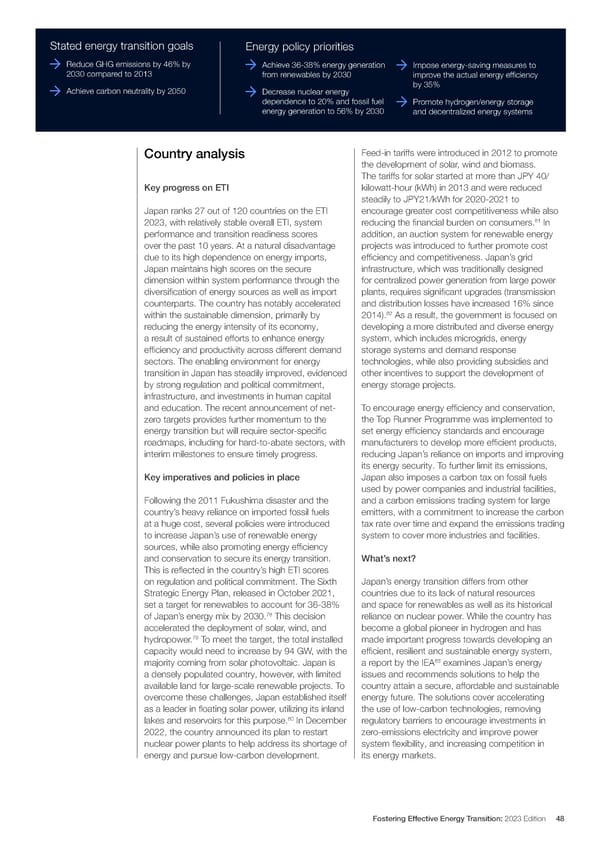Stated energy transition goals Energy policy priorities Reduce GHG emissions by 46% by Achieve 36-38% energy generation Impose energy-saving measures to 2030 compared to 2013 from renewables by 2030 improve the actual energy ef昀椀ciency Achieve carbon neutrality by 2050 Decrease nuclear energy by 35% dependence to 20% and fossil fuel Promote hydrogen/energy storage energy generation to 56% by 2030 and decentralized energy systems Feed-in tariffs were introduced in 2012 to promote Country analysis the development of solar, wind and biomass. The tariffs for solar started at more than JPY 40/ Key progress on ETI kilowatt-hour (kWh) in 2013 and were reduced steadily to JPY21/kWh for 2020-2021 to Japan ranks 27 out of 120 countries on the ETI encourage greater cost competitiveness while also 2023, with relatively stable overall ETI, system reducing the 昀椀nancial burden on consumers.81 In performance and transition readiness scores addition, an auction system for renewable energy over the past 10 years. At a natural disadvantage projects was introduced to further promote cost due to its high dependence on energy imports, ef昀椀ciency and competitiveness. Japan’s grid Japan maintains high scores on the secure infrastructure, which was traditionally designed dimension within system performance through the for centralized power generation from large power diversi昀椀cation of energy sources as well as import plants, requires signi昀椀cant upgrades (transmission counterparts. The country has notably accelerated and distribution losses have increased 16% since within the sustainable dimension, primarily by 2014).82 As a result, the government is focused on reducing the energy intensity of its economy, developing a more distributed and diverse energy a result of sustained efforts to enhance energy system, which includes microgrids, energy ef昀椀ciency and productivity across different demand storage systems and demand response sectors. The enabling environment for energy technologies, while also providing subsidies and transition in Japan has steadily improved, evidenced other incentives to support the development of by strong regulation and political commitment, energy storage projects. infrastructure, and investments in human capital and education. The recent announcement of net- To encourage energy ef昀椀ciency and conservation, zero targets provides further momentum to the the Top Runner Programme was implemented to energy transition but will require sector-speci昀椀c set energy ef昀椀ciency standards and encourage roadmaps, including for hard-to-abate sectors, with manufacturers to develop more ef昀椀cient products, interim milestones to ensure timely progress. reducing Japan’s reliance on imports and improving its energy security. To further limit its emissions, Key imperatives and policies in place Japan also imposes a carbon tax on fossil fuels used by power companies and industrial facilities, Following the 2011 Fukushima disaster and the and a carbon emissions trading system for large country’s heavy reliance on imported fossil fuels emitters, with a commitment to increase the carbon at a huge cost, several policies were introduced tax rate over time and expand the emissions trading to increase Japan’s use of renewable energy system to cover more industries and facilities. sources, while also promoting energy ef昀椀ciency and conservation to secure its energy transition. What’s next? This is re昀氀ected in the country’s high ETI scores on regulation and political commitment. The Sixth Japan’s energy transition differs from other Strategic Energy Plan, released in October 2021, countries due to its lack of natural resources set a target for renewables to account for 36-38% and space for renewables as well as its historical 78 of Japan’s energy mix by 2030. This decision reliance on nuclear power. While the country has accelerated the deployment of solar, wind, and become a global pioneer in hydrogen and has 79 To meet the target, the total installed hydropower. made important progress towards developing an capacity would need to increase by 94 GW, with the ef昀椀cient, resilient and sustainable energy system, majority coming from solar photovoltaic. Japan is 83 examines Japan’s energy a report by the IEA a densely populated country, however, with limited issues and recommends solutions to help the available land for large-scale renewable projects. To country attain a secure, affordable and sustainable overcome these challenges, Japan established itself energy future. The solutions cover accelerating as a leader in 昀氀oating solar power, utilizing its inland the use of low-carbon technologies, removing 80 In December regulatory barriers to encourage investments in lakes and reservoirs for this purpose. 2022, the country announced its plan to restart zero-emissions electricity and improve power nuclear power plants to help address its shortage of system 昀氀exibility, and increasing competition in energy and pursue low-carbon development. its energy markets. Fostering Effective Energy Transition: 2023 Edition 48
 Fostering Effective Energy Transition 2023 Page 47 Page 49
Fostering Effective Energy Transition 2023 Page 47 Page 49